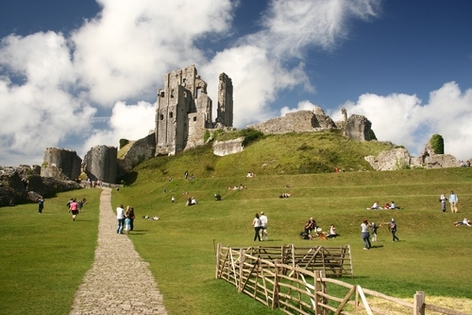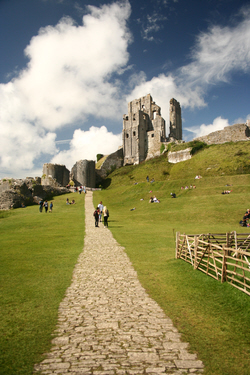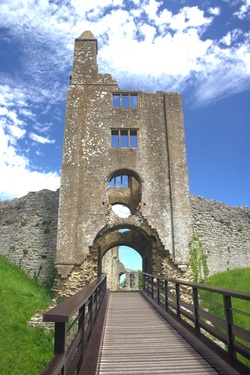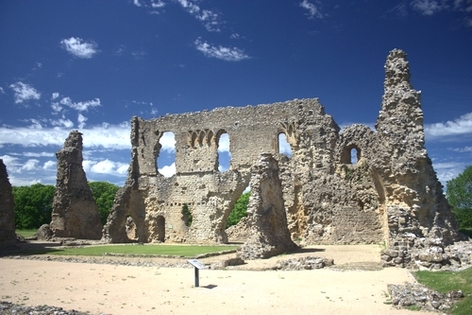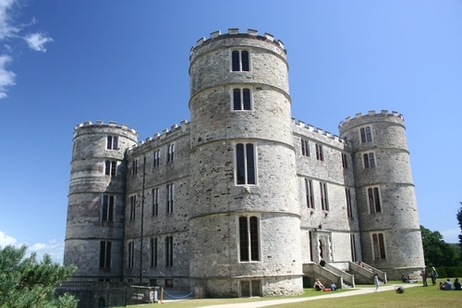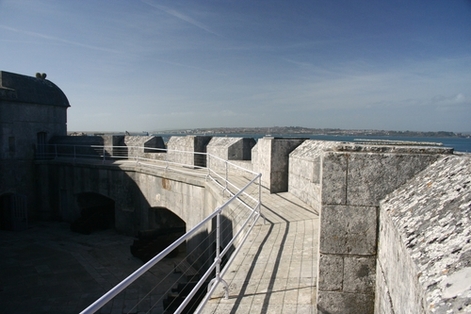Castles...
|
If you’re looking for an historic castle, Dorset might not be the first place that springs to mind. And yet this beautiful county has plenty to choose from.
Think Castle, and all the big names will trip off the tongue: Windsor Castle; Edinburgh Castle; Caenarfon Castle; Carmarthen; Leeds; Dover; Warwick; Arundel; Alnwick. The list, while not endless, goes on and on, prompting some to produce “charts” of Britain’s “Top Ten” castles. The National Trust and English Heritage both have web lists of “Top Ten Castles”, although each confines itself to a chart run-down based on properties each organisation actually owns or manages itself. Even so, out of the Top Twenty Castles that these two august bodies list between them, only one is in Dorset, and that is the National Trust’s Corfe Castle. True, the NT has Corfe Castle down as number four in its national castellated hit parade, but Dorset has far more to offer on the castle front than just this magnificent Purbeck ruin. What’s more, when it comes to the history of castles and fortifications, Dorset can take you on a historical journey from some of the earliest manifestation of castles to some of the last major fortifications to be built in the UK. Corfe Castle sits broadly in the middle of Dorset’s fortifications story. It was built by the Normans sometime after William beat Harold at Hastings in 1066. It was constructed to the motte and bailey style favoured by the Normans and would doubtless still be standing today had it not been ruined by Parliamentarians towards the end of the English Civil War. A similar fate befell the Old Sherborne Castle, another Norman example, which Oliver Cromwell himself ordered to be destroyed. Fortunately, by the time of its destruction a second “New” Castle was already taking shape at Sherborne, thanks to Sir Walter Raleigh, who having obtained the Castle and estate at Sherborne from Elizabeth I, decided the Old Castle would be too expensive to convert into the stately home he planned. Hence the New Sherborne Castle, which is still standing today. The New Castle at Sherborne started life as a hunting lodge, which, coincidentally, is what Lulworth Castle was purpose built for, at around the same time as the new Castle at Sherborne was taking shape. While Sherborne and Lulworth Castles sit more at the homely end of the castle spectrum, Portland Castle is very much a state-of-the-art fortified defensive position, with impressive offensive capacity. Built by Henry VIII as one of a pair protecting anchorages at Portland, this compact castle uses the best design features that the Tudors had available to pack a hefty punch, while, hopefully, protecting its guns and gunners from incoming naval fire. While Portland Castle remains intact, its sister Sandsfoot Castle, is a ruin on the other side of what is now Portland Harbour. As well as its Tudor castle, Portland is also home to a much later stone-built Victorian defence. The Verne (which is now a prison) and its “high angle batteries”, near Tout Quarry, were built in the 1890s. Some 30 years earlier, construction started on the Nothe Fort in Weymouth. Whilst the Nothe saw action as a anti-aircraft position in World War II, Portland's high angle batteries themselves were virtually obsolete before they were built because of the rapidly developing technology of the Victorian era. The imposing stone and concrete edifices of the Verne Citadel and the Nothe Fort were among some of the last defences of their kind built in Britain. But Dorset is also home to some of the earliest too. Maiden Castle, near Dorchester, was the site of a huge battle between the invading Roman Empire and the iron age Celts. The result is, as they say, history and parts of the massive earthworks were later used by the Romans, as were the area around what is now Dorchester and Poundbury, where there are remains of a further fortified iron age camp. Maiden Castle is the largest earthwork of its type in Europe, but other smaller fortifications in Dorset of the same time and similar design include Eggardon Hill and Badbury Rings to name just two. Throw into this mix formerly walled-towns like Dorchester, Wareham and Shaftesbury (whose walls can still be walked) and it is clear to see that Dorset has a pedigree spanning two thousand years or more when it comes to castles, forts and fortifications. As if that isn’t enough for castle-buffs of greater or lesser degree, the county also played a big part in the life of T. E. Lawrence. Although Lawrence became famous for his exploits in Arabia he started his career as an expert in castles at home and abroad. So, if you are looking for an historic castle, or people who knew about and were interested in them, Dorset really should be high on your list, if not your number one! |
If you’re looking for an historic castle, Dorset might not be the first place that springs to mind. And yet this beautiful county has plenty to choose from.."
|
